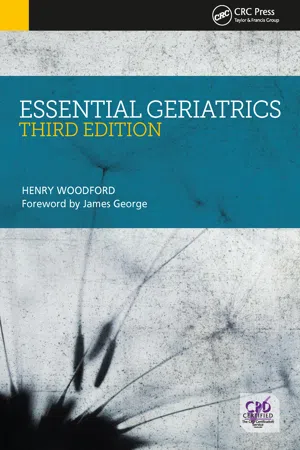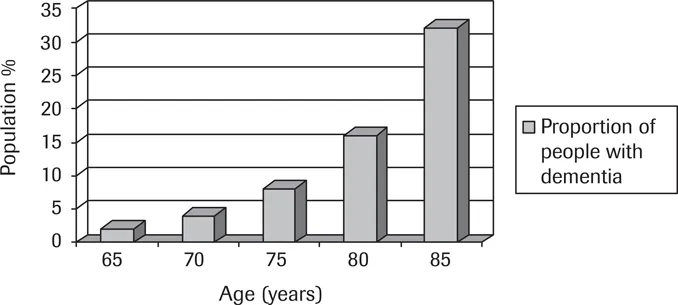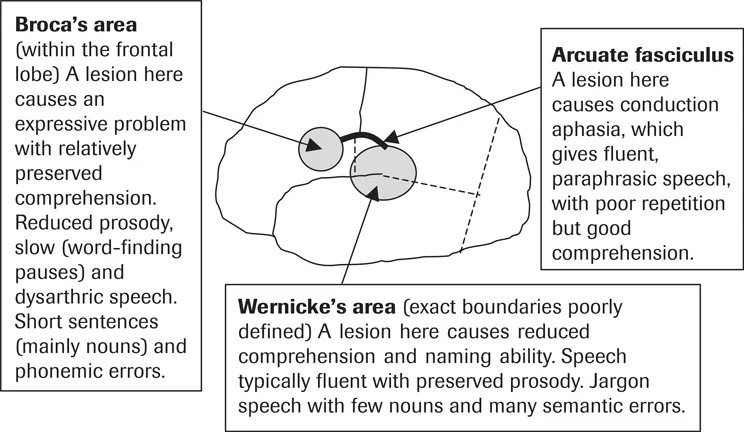
- 512 pages
- English
- ePUB (mobile friendly)
- Available on iOS & Android
eBook - ePub
Essential Geriatrics, Third Edition
About this book
This third edition of Essential Geriatrics has been comprehensively updated and expanded, and now includes over 200 questions and answers throughout the text in the 'best of five' format. This text specifically focuses on the key aspects of elderly care, spanning both general medicine and the particular problems encountered in geriatrics as a
Frequently asked questions
Yes, you can cancel anytime from the Subscription tab in your account settings on the Perlego website. Your subscription will stay active until the end of your current billing period. Learn how to cancel your subscription.
No, books cannot be downloaded as external files, such as PDFs, for use outside of Perlego. However, you can download books within the Perlego app for offline reading on mobile or tablet. Learn more here.
Perlego offers two plans: Essential and Complete
- Essential is ideal for learners and professionals who enjoy exploring a wide range of subjects. Access the Essential Library with 800,000+ trusted titles and best-sellers across business, personal growth, and the humanities. Includes unlimited reading time and Standard Read Aloud voice.
- Complete: Perfect for advanced learners and researchers needing full, unrestricted access. Unlock 1.4M+ books across hundreds of subjects, including academic and specialized titles. The Complete Plan also includes advanced features like Premium Read Aloud and Research Assistant.
We are an online textbook subscription service, where you can get access to an entire online library for less than the price of a single book per month. With over 1 million books across 1000+ topics, we’ve got you covered! Learn more here.
Look out for the read-aloud symbol on your next book to see if you can listen to it. The read-aloud tool reads text aloud for you, highlighting the text as it is being read. You can pause it, speed it up and slow it down. Learn more here.
Yes! You can use the Perlego app on both iOS or Android devices to read anytime, anywhere — even offline. Perfect for commutes or when you’re on the go.
Please note we cannot support devices running on iOS 13 and Android 7 or earlier. Learn more about using the app.
Please note we cannot support devices running on iOS 13 and Android 7 or earlier. Learn more about using the app.
Yes, you can access Essential Geriatrics, Third Edition by Woodford Henry in PDF and/or ePUB format, as well as other popular books in Medicine & Family Medicine & General Practice. We have over one million books available in our catalogue for you to explore.
Information
PART B
Brain
CHAPTER 6
Dementia
DEFINITION
Dementia is a syndrome attributed to disease of the brain, usually of a chronic or progressive nature, in which there is disturbance of multiple brain functions. These impairments may include calculation, learning capacity, language and judgement. It is usually only considered present when there is resultant impact on social or occupational function. Consciousness is usually unaltered. There may also be deterioration in emotional control, social behaviour or motivation. In other words, it is not simply memory loss but a complex condition that affects more than one aspect of cognition.
EPIDEMIOLOGY
Approximately 8–10% of people over the age of 65 years in the Western world have dementia. The prevalence rises from around 2% of those aged 65 to more than 35% of those over 85 years (Figure 6.1).1–3 This figure represents, roughly, a doubling in prevalence for every five-year increase in age. A more positive thought is that around two-thirds of the very old do not have dementia. The number of people worldwide with dementia is predicted to double every 20 years.4 The prevalence of dementia is higher among hospitalised older people – being present in around 48% of those aged 80–89 and 66% of those aged over 90.5

In addition, there is a significant population of individuals with some clinical evidence of cognitive impairment that is not severe enough to meet the criteria for a diagnosis of dementia (‘mild cognitive impairment’ – see p. 94). However, cognitive decline is not an inevitable feature of ageing and many older people continue to function at their baseline level (see p. 14).6
Mortality rates are increased in people with dementia compared to people without this condition. Survival time is heavily dependent on age at the time of diagnosis. A study found that people aged 65–69 years survived a median of 10.7 years, those aged 70–79 survived 5.4 years, those aged 80–89 survived 4.3 years, and those over 90 survived 3.8 years.7 The overall median survival time was 4.5 years.
COGNITION
Attention
Attention is the ability to focus on a task and is determined by both concentration and arousal. It is mediated by the reticular activating system, which is a complex series of connections between the cerebral cortex, thalamus and the reticular formation (a ‘net-like’ collection of cells on the surface of the brainstem). In the presence of reduced attention other brain functions are also impaired.
Memory
Traditionally memory function has been loosely divided into short-term and long-term components. More recently, memory has been classified into four categories,8 these are outlined below.
➤ Episodic memory: The memory of specific personal events and experiences, for example what you did on holiday last year. Predominantly mediated by the medial temporal lobes and limbic system (including the hippocampus – see Figure 6.7). Insults to this system tend to affect more recently learned memories more than older ones (i.e. short-term memory is more affected than long-term memory).
➤ Semantic memory: Knowledge of the world not related to personal experiences. This includes the names of objects, for example the names of animals. This is predominantly mediated by the inferolateral temporal lobes.
➤ Procedural memory: The memory of how to perform tasks, such as riding a bike. The basal ganglia and cerebellum predominantly mediate this. It occurs at a subconscious level. It may be particularly affected in movement disorders (see Chapter 9).
➤ Working memory: Short-term (seconds to minutes) ‘keeping it in your head’. It can be phonologic (e.g. a phone number) or spatial (e.g. manipulating an object in your mind). The prefrontal cortex is important in this process along with other brain areas depending on the nature of the task. For an effective working memory, it is also necessary to be able to maintain attention/concentration.
Memories may be conscious (declarative) or non-conscious (non-declarative). Confabulation is the making-up of new ‘memories’ to replace those that have been lost. Memory impairment is common to many disorders, including dementia, delirium and depression.
Language
The dominant hemisphere encodes language. In all right-handed and most left-handed people this is the left side of the brain. The language centres are more diffuse and less well defined than traditionally thought. They include Broca’s area in the frontal lobe and Wernicke’s area at the margin of the temporal and parietal lobes. There is also a network of connections between these areas, called the arcuate fasciculus (see Figure 6.2). Paraphrasia is a term for the use of abnormal or incorrect words. These can be semantic (similar categories, e.g. ‘dog’ for ‘cat’), phonemic (similar sounds, e.g. jar for car) or neologistic (made up words, e.g. strub for car). Prosody is a term for the melodic characteristics of speech including intonation, stress and cadence (rhythm). Anomia is a term for a naming deficit (e.g. cannot say the name for a pen). Anomic dysphasia is also called ‘word block’. With this disorder people typically stop mid-sentence. Its presence is associated with space-occupying lesions within the dominant lobe. Progressive aphasia is a term for a slowly worsening non-fluent aphasia secondary to left frontotemporal degeneration (plus apraxia). Dysgraphia (impaired writing) and dyslexia (impaired reading) are usually associated with dysphasia.

Visuospatial skills
Visuospatial deficits tend to be more severe with non-dominant hemisphere damage but are not unique to it. Constructional ability involves input from occipital (visual), parietal (association areas link visual and motor pathways) and frontal (motor) lobe functions.
Errors observed include perseveration (repetition of lines/shapes) and ‘closing in’ (merging objects together). Constructional ‘apraxia’ can occur with damage to either hemisphere. When affecting the left over-simplification of copied objects is seen, with the right an over-elaboration or ‘explosion’ of constituent parts is more typical. ‘Neglect’ is a term used for spatial inattention, which can cause visual or sensory extinction (stimuli are preferentially detected by one side of the body despite intact sensory systems).
Executive function
The frontal lobes perform executive functions, which relate to personality (drive, motivation, inhibition) and behaviour. Lesions here lead to failures with learning from errors, poor goal setting, intrusion of unwanted thoughts, perseveration (becoming fixed on one idea), the inability to switch tasks (also called ‘set-shifting’, leading to ‘stimulus-bound’ behaviour), reduced empathy, and poor sequencing of tasks. Affected individuals typically have reduced interest in their environment and poor social drive leading to impaired interpersonal relations and hygiene.
Apraxia
Apraxia is a high-level motor deficit. It is mainly seen with left hemi...
Table of contents
- Cover
- Title Page
- Copyright Page
- Table of Contents
- Dedication
- Foreword to the third edition
- About the author
- List of figures
- Introduction
- Part A: Medicine and old age
- Part B: Brain
- Part C: Bladder and bowel
- Part D: Falls and related topics
- Part E: Cardiovascular
- Part F: Selected topics
- Appendix A: Rating scales
- Appendix B: Abbreviations
- Appendix C: Answers to questions
- Index